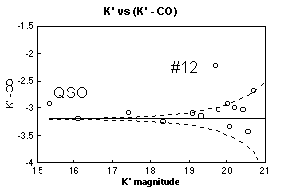Protogalaxy Candidate at z=2.5
Narrow-band infrared imaging has revealed a faint red galaxy with a strong (equivalent-width = 2%) emission line at 2.30 microns. The field was observed because of its proximity to the quasar SBS 0953+549, which has a metal absorption-line system at z(abs) = 2.50. The emission-line galaxy is only separated from the quasar line of sight by a projected distance of 240 kpc, and we identify the emission line as H-alpha/[NII] in a galaxy which is in the same group as the z = 2.50 absorber. Since all the galaxy properties are also consistent with a young age and a redshift of 2.5, it is a prime candidate for a protogalaxy.
Reference: Malkan, Teplitz, & McLean 1995, ApJ 448, L5
These images were taken with the 10-m Keck Telescope using the Near IR Camera (NIRC).

|

|
| K' image of the field SE of SBS 0953+549 | 2.30 micron image of the same field |
|---|

|
The color-magnitude diagram shows the difference in instrumental magnitude between the K' and 2.30 micron filters for each object in the frame. Only the QSO, which has very broad H-alpha emission centered at z = 2.58, and Galaxy #12 show excess flux. The dotted horizontal line indicates the expected flux difference based on filter widths and transmission; the curved dotten lines indicated +/- 1 sigma errors. |
